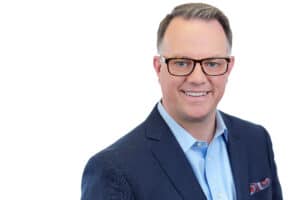Matthew Powers
CEO, Nan Fung Life Science Real Estate
Age: 46
Industry experience: 25 years
Late-night Zoom calls to Hong Kong are just part of the daily drill for Matthew Powers, a Boston real estate executive named in November to head Nan Fung Life Science Real Estate. With $1 billion to spend this year on acquisitions of commercial real estate in Boston and other U.S. metros with thriving life science sectors, Powers has maintained a full work schedule throughout the COVID-19 pandemic.
After establishing a U.S. headquarters in Boston last year, Nan Fung Life Science Real Estate is poised to challenge the established industry players as a landlord for growing early-stage biotech research firms. The firm is a subsidiary of Nan Fung Group, a Hong Kong conglomerate that has roots in the family fortune of the late textile tycoon Chen Din-hwa. Powers got his start in the life science industry working for Genzyme in 1995 and most recently led the New England life sciences practice for JLL.
Q: What’s Nan Fung Life Science Real Estate’s business plan for acquisitions and development in Boston and beyond?
A: We’re based here and have a great team, and the focus is on Boston, San Francisco, New York and we’re also looking into London. There’s an unmet need to deliver space into the market. For groups like Alexandria Real Estate Equities and Blackstone, below a certain scale it doesn’t make sense for them to do certain projects. We saw the opportunity to come in because we’re so well capitalized, do 100 percent–cash deals, owner’s equity deals. I don’t have to find a capital partner, so we can be really flexible.
There’s a significant pipeline of projects that deliver in 2022 to 2024. We can do a cash deal and a complete turnkey buildout that doesn’t require tenants to put any capital into the deal. All they have to do is pay rent. The projects we’re looking at, we’re vetting it and figuring out what we can do by-right and zoning, and can turn these around in nine months. The buildings we’re doing in Boston right now are basically an interior renovation project. We work with inspectional services, get approval and do a nine-month conversion.
Q: So, the buildout takes place before you have signed leases?
A: We’re building spec suites that really cover 80 percent of the market right now. We have to have ubiquitous utilities built into the space to move things around. If we’re eight months in and a great says, “I’d like to have that other space,” we need to be able to move that around. We spent a lot more money upfront, but in the longer run, some lab buildings need more tenant improvements down the road. Theoretically, we’re not going to have to do that.
Q: What was it about your first two acquisitions in Boston, 51 Sleeper St. and One Winthrop Square, that made sense for life science conversions?
A: 51 Sleeper St. was a no-brainer for us, just the location at the gateway to the Seaport, unobstructed views of the harbor and Fort Point Channel. There was existing vacancy there. It’s efficient, with 25,000-square-foot floor plates. [Previous owner] Brookfield did a great job improving the building. United Way was a tenant on two-and-a-half floors and they were looking to downsize, so we worked out a cost savings to terminate their lease early and allowed us to do the lab conversion faster. One Winthrop Square’s location is phenomenal. At one point it was the old Boston Herald printing press, so the infrastructure was amazing. The floor–to–floor heights are 16 to 24 feet and architecturally, and it’s one of the most beautiful buildings in downtown Boston.
Q: Is NFLSRE focusing exclusively on urban locations, and are you looking outside the city of Boston?
A: The mayor has done a really good job in attracting life sciences to Boston and making this the Greater Boston-Cambridge life science cluster. We have great respect for Alexandria and BioMed and MIT. Those guys are in East Cambridge and that’s a really competitive market. We think there’s a really interesting opportunity on the Boston side of the river: great buildings that have great infrastructure and transportation.
Q: How have you seen life science space requirements changing since the advent of COVID-19?
A: The densities we used to look at – say, 285 to 300 square feet per scientist in a lab space – companies now are thinking maybe that number needs to balloon up to 450 square feet per scientist. But wet lab and life science research has to be done in a bench setting regulated by all the government controls for fume hoods and chemical storage. These are things that can’t be done working from home.
Q: Are you considering ground-up development?
A: We are. We’re like the personalized medicine real estate developer. In the past, ultimately you’d sell your biotech firm to Pfizer or Novartis because you need this giant manufacturing operation. Now it’s very targeted: one product for Asia, one for Europe, one for the U.S. That lends to a ground-up development like Moderna in Norwood. If we can accommodate a multinational life science company that wants a large presence or headquarters, our turnkey model lends well to that. Right now we really love the opportunities for these early- and mid-stage companies in and around Boston. When they need to expand to manufacturing, we’re hoping they stay with us and do the ground-up development for them.
Powers’ Top 5 Sports Moments of the 21st Century
- David Ortiz 2013 proclamation, “This is our ‘[expletive]’ city”
- Adam Vinatieri’s winning field goal in Super Bowl XXXVI
- Johnny Damon’s grand slam in game 7 of the 2004 World Series
- Tim Thomas’ shutout in game 7 of 2011 Stanley Cup Finals
- Eddie House’s 3-pointer in game 4 of 2008 NBA finals






